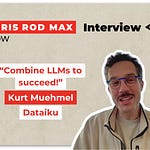In this episode, Chris Rod Max discuss the latest trends in AI, focusing on Mistral’s business model, its competition with OpenAI, and the implications of European AI initiatives.
They explore the challenges of AI regulation, the importance of the application layer, and the rise of text-to-web app builders, while also considering the potential impact on developer skills and innovation.
In this conversation, the hosts explore the emerging concept of ‘Vibe Coding’, the implications of Elon Musk’s bid for OpenAI, the challenges posed by deepfakes, and the importance of critical thinking in an era of misinformation.
They discuss how technology is changing the way we learn and interact, the potential consequences of deepfake technology on trust and security, and the need for individuals to verify information in a rapidly evolving digital landscape.
Chapters
00:00 Introduction to AI Trends and Mistral
01:27 Mistral’s Business Model and Market Positioning
06:41 Comparative Analysis of AI Models
09:16 European AI Landscape and Nationalistic Push
14:20 Regulatory Challenges and Political Dynamics
17:05 The Application Layer and AI Development
19:47 Text-to-Web App Builders and Their Challenges
26:19 The Rise of Vibe Coding
29:59 Elon Musk’s Bid for OpenAI
39:47 The Deepfake Dilemma
49:14 Navigating Misinformation in the AI Era
Takeaways
Mistral's focus on business and open-source models faces challenges: Despite efforts to differentiate itself from OpenAI and Anthropic, Mistral's impact remains regional, with limited global adoption. Its funding is significantly lower, raising concerns about long-term competitiveness.
Deepfakes and AI-driven misinformation are rising threats: From financial fraud to manipulated media, deepfake technology is creating security risks. The need for robust identity verification and critical thinking in consuming online content is becoming more urgent.
AI-powered app builders lower barriers but still require human oversight: While AI-driven development tools accelerate prototyping, they struggle with complex integrations and debugging. "Vibe coding" enables rapid iteration, but over-reliance may erode fundamental programming skills.
YouTube Episode
Spotify Podcast
Episode Transcript
Introduction and Welcome
Maxson Tee (00:05) Welcome back to another episode of the Chris Rod Max Show. Today we’re joined by Chris and Rod to discuss the latest developments in AI. We’ll be covering several fascinating topics: Mistral’s business strategy, the evolution of web-text-to-app applications, Elon Musk’s attempt to acquire OpenAI, and the growing concerns around deepfakes and AI-generated news distortion. Let’s dive right in.
Mistral’s Business Focus and Strategy
Maxson Tee (01:00) Let’s begin with Mistral’s recent developments. TechCrunch recently published an article about Mistral’s focus on business users. I’ve been following this trend for several months, observing their engagement with banks and organizations to implement Mistral models internally. However, the business model and pricing structure remain unclear. I’d love to get your thoughts on two key aspects: 1. Mistral’s potential business model, especially given Llama’s open-source approach 2. The contrasting strategies between Mistral and competitors like ChatGPT and Anthropic
Rod, as someone who’s been experimenting with these applications, what’s your perspective both as a user and a builder?
Rod (02:34) There are several interesting developments here. Mistral recently launched their mobile application called Le Chat, and social media immediately lit up with praise, particularly from French users. However, the reality is more nuanced - in the UK, for instance, it’s not even in the top 200 most downloaded apps on the App Store, only reaching around top 22 in the productivity category.
Regarding funding, Mistral has raised 1 billion euros, which sounds impressive until you compare it with OpenAI’s funding of approximately 22 billion. Even Anthropic has raised around 14 billion. This funding gap is reflected in model performance - while Mistral’s models are good, they’re now significantly behind competitors like DeepSeek.
Chris (06:41) From an Asian perspective, Mistral isn’t really part of the conversation here. The focus is more on DeepSeek, OpenAI, or Microsoft Copilot. What’s interesting about Mistral’s enterprise approach is its strong French connection - their current business relationships appear to be primarily with French companies.
The recent AI summit featuring President Macron’s support for Mistral seems to indicate a nationalistic push, especially given AI’s increasingly political nature between the US and China. My LinkedIn and X feeds are full of commentary about Europe having another chance in the AI race.
Regulatory Considerations and European AI Strategy
Rod (09:16) I suspect European companies like Mistral will only achieve parity with global players if we see regulations requiring European governmental agencies and large companies to use European models. It could be similar to GDPR, where data must be stored in the European Union - perhaps we’ll see requirements for AI models to be European for use by Europeans.
Maxson Tee (10:01) That’s an interesting perspective. We can see similar approaches in different regions. China, for example, restricted Visa’s entry until UnionPay was established, believing certain infrastructure was too critical to rely on foreign providers. India took a different approach by building more performant systems like UPI and Aadhaar.
The challenge for Europe is coordination across 27 countries. While Mistral may excel in French, handling multiple European languages could be complex.
Text-to-Web App Development
Maxson Tee (19:33) Let’s discuss A16Z’s recent article about using prompts to build products and the rise of AI-powered web app builders. Both of you have entrepreneurial experience - what are your thoughts on how text-to-web app development is evolving?
Rod (19:47) When we look at the most popular app categories online, they’re essentially blogs, shops, CRMs, and ERPs. Despite the variety we see, most applications fundamentally do simple things: present content, manage products, or structure and visualize data. The real innovation here is that when the cost of building software approaches zero, and anyone can build, we might finally achieve Steve Jobs’ vision of computers as ‘bicycles for the mind’ - lean, malleable tools used efficiently for specific purposes.
OpenAI Acquisition Attempt
Maxson Tee (30:54) Let’s discuss Elon Musk’s attempt to buy OpenAI. He’s leading a consortium offering $97 billion, while OpenAI is seeking $40 billion at a $300 billion valuation. Sam Altman’s response on X was simply “no thanks,” with a counter-offer to buy X for $9.7 billion. What are your thoughts on Musk’s stated intention to keep OpenAI non-profit?
Rod (32:07) This situation can be viewed from multiple angles. Looking at OpenAI’s current structure, a software engineer’s total compensation can reach 1.2 million per year, including stock grants. This requires significant cash flow and constantly increasing valuation to maintain such compensation packages. It’s challenging to sustain this in a non-profit model.
Deepfakes and AI Security
Maxson Tee (40:45) Let’s address the growing concern about deepfakes, sparked by Scarlett Johansson’s recent call for government regulation. Gartner predicts that by 2026, 30% of enterprises will consider identity verification and authentication unreliable due to deepfakes. How are your networks responding to this threat?
Rod (41:09) This isn’t entirely new - we’ve dealt with photo manipulation since the early internet days. However, the current situation is more dangerous because we can now bypass security checks and identification systems. We might need to return to offline processes for certain verifications, similar to how bank accounts once required in-person verification.
Chris (42:54) I expect we’ll see much more emphasis on two-factor authentication and cybersecurity measures. Business operations will likely become more complex - think about how we now need to sign into Microsoft every few days. Universities are already working on PhD topics about securing against deepfakes and developing AI-generated content detection.
Closing Remarks
Maxson Tee (51:50) Thank you everyone for tuning in. Remember the 80-20 rule we discussed: AI can handle 80% of the work, but you need to know your goals for the remaining 20%. We’ve covered Mistral’s focus, text-to-app development, Musk’s OpenAI bid, and the challenges of deepfakes and AI-generated news. Join us next time for more insights into the evolving world of AI.
Rod (52:48) You can find us at chrisrodmax.com
Your Hosts
Follow:
Chris: https://linkedin.com/in/christinewang0/
Rod: https://linkedin.com/in/rodriveracom/
Max: https://linkedin.com/in/maxsontjy/
Social: X: https://x.com/chrisrodmax
Instagram: https://instagram.com/chrisrodmax
LinkedIn: https://linkedin.com/company/chrisrodmax
Subscribe: https://chrisrodmax.com














Share this post